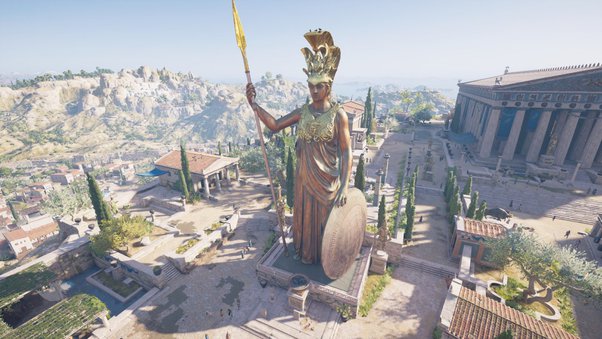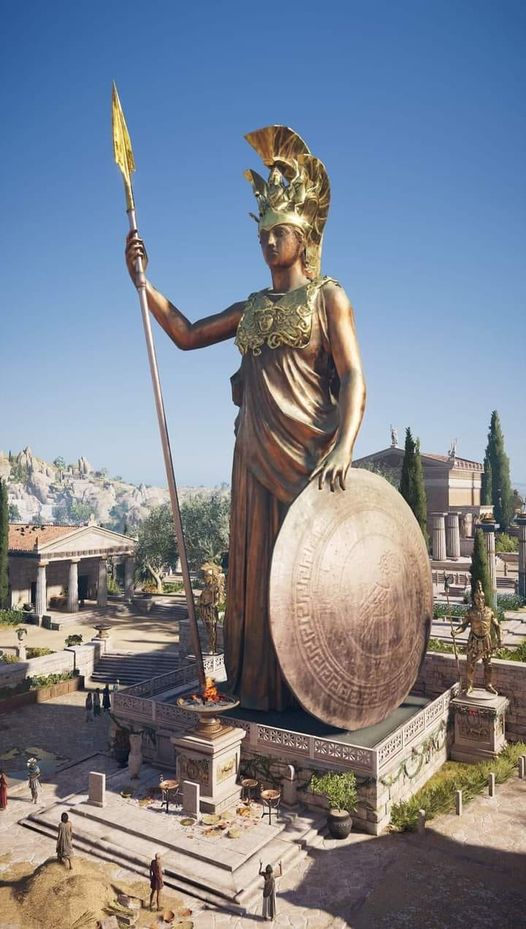Phidias’ enormous bronze statue of Athena Promachos, which stood between the Parthenon and the Propylaeus on the Acropolis of Athens in 456 BC,

Athena Promachos, translating to “Athena who fights on the front line,” was a monumental bronze statue that embodied the warrior aspect of the goddess Athena. This colossal statue was masterfully sculpted by Phidias, one of the most renowned sculptors of ancient Greece. Erected in 456 BC, Athena Promachos stood proudly between the Propylaeus and the Parthenon on the Acropolis of Athens, serving as a powerful symbol of the city’s strength, protection, and reverence for their patron goddess.
Phidias, celebrated for his expertise in large-scale sculptures, undertook the commission to create a statue that would not only honor Athena but also inspire the Athenian people. The project was part of Pericles’ extensive building program aimed at showcasing Athens’ glory and power during its Golden Age. Athena Promachos was designed to be a commanding presence, visible from far out at sea, signifying the might and vigilance of the city-state.

The statue itself was an engineering marvel. Standing approximately 9 meters (30 feet) tall, Athena Promachos was crafted from bronze, a material that signified durability and strength. Phidias’ skillful artistry ensured that the statue captured both the grandeur and the fierce demeanor of the goddess. Athena was depicted in full armor, holding a shield in one hand and a spear in the other, ready to lead and protect her people. Her helmet was adorned with a crest, further emphasizing her role as a warrior goddess.
Positioned strategically on the Acropolis, the statue was flanked by two of Athens’ most significant architectural masterpieces—the Propylaeus, the grand entrance to the Acropolis, and the Parthenon, the temple dedicated to Athena Parthenos (Athena the Virgin). This location was highly symbolic, as it linked the protective and martial aspects of Athena with her more serene and civic roles. Visitors ascending the Acropolis would first encounter the imposing figure of Athena Promachos, a reminder of the city’s military prowess and divine guardianship before entering the sacred precinct of the Parthenon.

Athena Promachos held immense cultural and symbolic importance for the Athenians. The statue represented the city’s dedication to Athena, who was not only the goddess of wisdom and warfare but also the protector of Athens. It was a constant reminder of the goddess’s role in ensuring the city’s safety and prosperity. The image of Athena Promachos also reinforced the unity and collective identity of the Athenian people, who saw themselves as under the direct protection of their patron deity.
The prominence of Athena Promachos extended beyond its physical presence. It influenced various aspects of Athenian life, including art, literature, and civic pride. The statue was frequently mentioned in historical texts and depicted in artworks, symbolizing the ideals of courage, strength, and divine favor. It served as a cultural icon that resonated with the values and aspirations of the Athenians.

Despite its eventual disappearance, the legacy of Athena Promachos endures. The statue, along with other works by Phidias, set a high standard for classical sculpture and left a lasting impact on the art and architecture of subsequent generations. The spirit of Athena Promachos can be seen in later representations of warrior deities and heroes, both in ancient and modern contexts.
In conclusion, Athena Promachos was not just a colossal bronze statue; it was a symbol of Athenian power, unity, and divine protection. Sculpted by Phidias and erected in 456 BC, the statue stood between the Propylaeus and the Parthenon on the Acropolis of Athens, where it inspired and protected the city’s inhabitants. Through its imposing presence and artistic excellence, Athena Promachos captured the essence of Athena as a warrior goddess and left an indelible mark on the cultural and historical landscape of Athens.